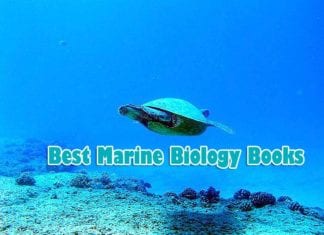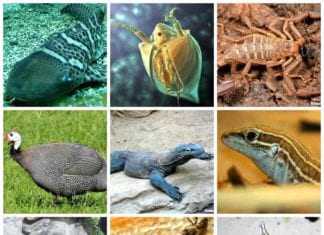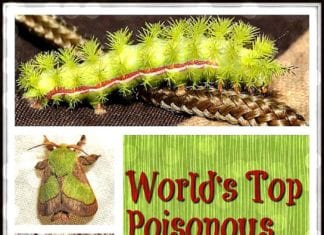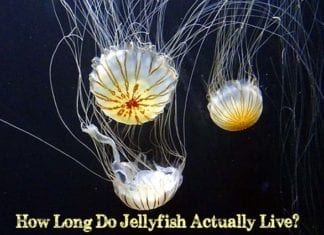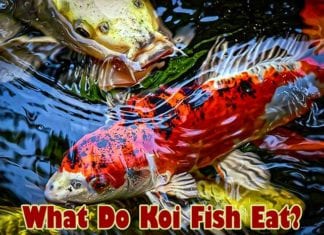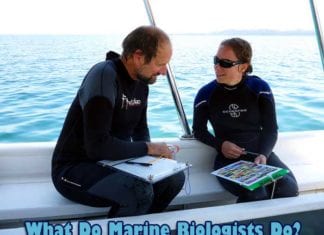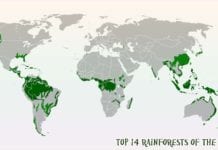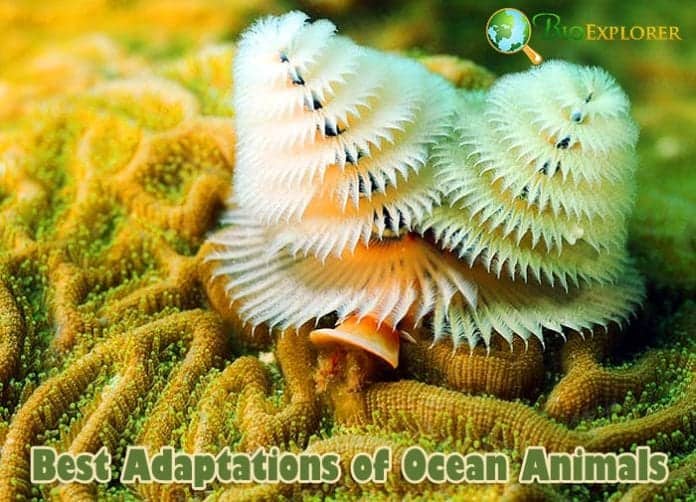
Ocean Animal Adaptations: For people looking from the shores, the ocean is just a vast body of saltwater. For animals and plants living in it, the ocean is a vast kaleidoscope of habitats – and all of them differ in temperatures, acidity, pressure, and multiple other conditions.
To survive in the ocean, living organisms have developed unique marine life adaptations to the areas they live in. Some of those adaptations are unexpected for humans who cannot survive in the water without assistance.
Why adaptation is a crucial part of evolution?
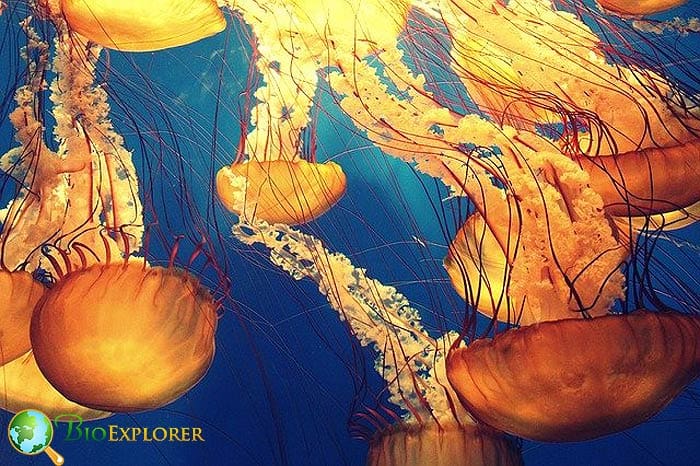
Most living beings have multiple adaptations. Adaptations are features of the organisms’ anatomy or physiology that have improved function, assisting the organism in surviving its environment. Adaptation can also be a process – a complex of subsequent changes in the population of organisms that leads to developing a new feature that makes these organisms better suited for the environment.
Not all anatomical structures are adaptations. For example, all fish have fins. In some fish, fins are limbs, not an adaptation. Some fish have significantly modified fins -for example, eels have long, shallow dorsal fins that run alongside their bodies. Thanks to such fins, the eels can swim differently from other fish, similar to snakes. This type of fin modification is an adaptation. They contribute to a function typical for a particular group of organisms (species, family, class).
Adaptations do not appear overnight; they are the result of a slow, complicated process. For adaptations to develop, several conditions have to be present:
- The living conditions for the organism have to change (for example, there is a temperature change in the area, less food, a new type of predator has appeared, etc. ).
- The population of this particular species is diverse, and each organism in it is slightly different.
- The changes in the organism can be inherited and passed on to future generations.
A similar list of conditions is also necessary for evolution to take place. No evolutionary changes would be possible if the living organism’s environment is stable or if the organisms in a group are identical. Evolution is only possible when:
- There are changes in the environment.
- The environmental changes are influential enough to lead to changes in the population.
- The population is not uniform, and the organisms within it react to the changes differently.
- The changes in the environment lead to the development of adaptations.
Suggested Reading:
Top 15 Best Marine Biology Books
As a result of adaptation to the changing environment, new types of organisms evolve. That is why adaptations are crucial for evolution.
The ocean is a volatile and diverse environment. The organisms living in different ocean areas receive different amounts of sunlight, oxygen, and food. Depending on where the animals live, they also have a different set of predators. This means that all ocean organisms have specific adaptations that help them survive in their particular area. Some of them are unique.
![]()
Ocean Animal Adaptations
Here are the marine animals with unique adaptations listed in no particular order:
Tiger pistol shrimp [a claw that generates a considerable shock wave]
Alpheus bellulus, a tiger pistol shrimp, is a crustacean of the Alpheidae family.
- This shrimp usually feeds on the leftover food and is known to have a symbiotic relationship with goby fishes.
- Though the animal is tiny, it has a powerful weapon that provides protection and sometimes kills an opponent.
- This shrimp has a specially structured claw capable of generating a powerful shock wave.
- When the shrimps‘ claw snaps, it creates a temporary vacuum, forming a bubble.
- The cavitation of the bubble leads to a water jet’s formation with a 25m/sec speed, enough to kill small prey or stun attackers bigger than the animal itself.
- The shrimp’s sound is also quite loud, which alerts the fish it lives with to hide from the danger.
![]()
Scale worm [Breathing structures on the appendages and 4-domain hemoglobin that better captures oxygen]
Branchipolynoe seepensis, or a sea worm, represents the broad class of invertebrates called polychaetes, or segmented worms.
- This particular species was found first in the 80s in the Gulf of Florida. These worms are unique in multiple ways.
- They usually live inside a particular species of mussels, Bathymodiolus azoricus, that live in deep-sea hydrothermal vents in Mid-Atlantic, in the Azores region.
- They are not parasites, but commensals – the mussels are simply used as “flats” for the worms.
- One of the vents’ main features where the mussel and its tenant reside is that oxygen is exceptionally scarce. The surroundings are rich in methane.
The most prominent problem with living in these conditions is hypoxia – lack of oxygen. To get as much oxygen as possible, B. seepensis has two major adaptations:
- Their appendages, called parapodia, have unique branching structures equivalent to gills or lungs in higher animals: they participate in gas exchange. This way, they have a large outside surface that allows them to get as much oxygen as possible while releasing carbon dioxide.
- These worms have a unique -hemoglobin structure it consists of 4 subunits or domains. The oxygen is attached to the hemoglobin, especially protecting the organism from hypoxia due to such structure.
Suggested Reading:
Carbon Cycle Steps: Overview & Importance in Biosphere
![]()
Asian sheepshead wrasse [Changes from female to male]
Asian sheepshead wrasse belongs to the Labridae family. They are common in the Western Pacific, especially in Japan and Korea.
- They are sometimes called Kobudai fish. These species are among the largest wrasses. They can reach up to 100 cm in length.
- They have distinctly protruding jaws, and the males of the species typically have bulbous growth on the head. The kobudai prefer to live in rocky reef areas.
- Kobudai is hermaphroditic and has both male and female organs. Initially, the young fish are female, and as they grow in size, they can change sex and become a larger, more aggressive male.
- This transformation was recently filmed in the BBC TV series Blue Planet II.
- The reason for this switch is usually explained by the fact that male sheepshead wrasses are polygamous – one male can have a harem of several female partners.
- In this case, it is advantageous to become a male when the animal gains weight and size, thus better able to defend one’s territory and partners and have more children.
Suggested Reading:
Top 15 Famous Marine Biologists
Top 18 BEST Tundra Animal Adaptations
![]()
Fanfin seadevil [Changes in the immune system that allow sexual parasitism]
Fanfin seadevil is one of the species from the anglerfish family. Anglerfishes prefer the deepest regions of the sea – approximately 1000-1500 meters below.
| Animalia | Lophiiformes | Caulophrynidae | Caulophryne | Caulophryne jordani |
- These fishes are recognizable by their flabby, round bodies, prominent sharp teeth, and a specialized “bait-like” structure that contains fluorescent bacteria.
- As the sea’s deep regions lack light, the “hanging bait” attracts potential prey as the only source of light.
- Besides the lack of food, anglerfish have another crucial problem – it is tough to find mates to reproduce.
- That is why females of the species are huge, with a prominent “fishing rod“, while the males are considerably smaller.
- The males lack a fishing rod but have large eyes and a good sense of smell, which helps to find females.
- When a male anglerfish finds an available female, it attaches to her very firmly with his teeth’ help.
- He stays there permanently, fusing with the body of the female fish. It gets the food from her and provides sperm to fertilize her eggs.
- This process is unique, as, in normal circumstances, the male would be rejected by the female fish’s immune system.
- It is different in anglerfishes because they have considerable changes in their adaptive immune system.
- Due to these changes, the male can stay fused until the end of his life.
- sexual parasitism and the immune system’s changes to make it possible are all adaptations to the environment where it is tough to find a mate.
Suggested Reading:
Top 10 Spectacular Asexual Reproduction In Animals
![]()
Flower urchin [Flexible spines with toxin as a defense mechanism]
Sea urchins belong to a class of animals called Echinodermata.
- Echinoderms are a very diverse and unique group that includes sea cucumbers, sea lilies, and sea stars.
- All sea urchins have one feature in common – a robust outer skeleton called test, to which multiple long spines are attached. The spines are a defense mechanism.
- Usually, they are made of calcium and are brittle. They can wound a potential predator, causing pain and potential infection.
- Some sea urchins are considerably more dangerous than others, and not because of their spines. A flower urchin can be found in the Indian and Pacific oceans, usually in the reef areas.
- It has the same round body as other urchins. Unlike regular urchins, the flower urchin has multiple feet-like appendages called pedicellaria besides spines.
- Usually, urchins only have these appendages on their lower surface and use them for movement. On the other hand, Flower urchins are entirely covered by different pedicellaria.
- Some of them are used to clear their bodies from debris. Others have flower-shaped endings. The latter is incredibly dangerous because they can attach themselves to the potential predator and inject a potent poison.
- This poison can cause paralysis and be dangerous even to adult divers. Compared to calcium spines, this type of defense is much more effective. The former is potentially dissolvable and does not inflict considerable damage besides possible infection.
- The more advanced defense mechanism has probably developed in these animals because many live in the coral reefs and are potential predators.
Suggested Reading:
World’s Top 15 Poisonous Caterpillars
![]()
Giant Sea Cucumber/California Sea cucumber [Expel their internal organs in defense]
Sea cucumbers are also members of the Echinodermata class. They have elongated bodies, often covered with spines or hair-like structures.
- They usually live on the ocean’s bottom and feed on debris.
- The giant sea cucumber is one of the largest species in this group of animals; its length ranges from 25 to 40 cm.
- This sea cucumber can be dark red, brown, or yellow. Its body has prominent pseudo splines called papillae.
- Some tentacles help with feeding around its mouth. As their name suggests, this species can be found in an area ranging from Alaska to California.
Like most sea cucumbers, this species has several unique adaptations:
- A unique structure called a respiratory tree is located near its anus. This structure helps the sea cucumber breathe.
- The California sea cucumber can absorb nutrients through the respiratory tree.
- The animal defends itself by expelling a part of its internal organs and then regenerating the expelled organs with time.
![]()
Blue bottle, Indo – Pacific man o’ war [A gas-filled sack that allows it to float]
A blue bottle or a Pacific man o’war looks like a jellyfish.
- It has a transparent, jelly-like body and is colored bright blue. This invertebrate is not a jellyfish.
- It belongs to another related group called siphonophores. Unlike jellyfish, it is a floating colony of specialized polyps.
- Each polyp has its function – some of them are catching prey, others are responsible for digestion or reproduction.
- The blue bottle has an elongated shape that resembles a bottle. It also has multiple long stinging tentacles that can reach up to 10 m long.
- A bluebottle is a forager. It can travel long distances because it has its own “air mattress” called a pneumatophore.
Suggested Reading:
How Long Do Jellyfish Live Or Are They Really Immortal?
Pneumatophores are specialized sacks filled with gas that help hold the bluebottle colony on water.
It should be noted that bluebottles are poisonous and can cause severe reactions. Another species is often called bluebottle as well – the Portuguese man o’war found in the Atlantic Ocean. The poison of the latter is significantly more dangerous and can potentially kill a human.
![]()
Yeti crab [Arms covered with hair, possibly for food farming]
Yeti crabs, Kiwa hirsuta, were discovered relatively recently, in 2015, during the expedition to the deep-sea hydrothermal vents in the Easter island area.
| Animalia | Decapoda | Kiwaidae | Kiwa | Kiwa hirsuta |
- These crabs can be found at the bottom of the sea, around hydrothermal vents in the Pacific, and close to Antarctica. Yeti crabs are yellowish-white in color, with prominent front pincers.
- All of their appendages are covered in long hair called setae, and the hair layer is incredibly thick on the front pincers.
- The scientists have observed that the crabs occasionally sit at the vents’ openings, waving their hairy pincers above them.
- It was also established that the hair contains many bacteria. It is supposed that the crabs support these bacterial colonies, providing them with nutrients emitted by the vents, and these bacteria are used as a supplemental food source.
![]()
Painted frogfish [An excellent camouflage]
It is tough to describe the painted frogfish because of how changeable it is.
| Animalia | Lophiiformes | Antennariidae | Antennarius | Antennarius pictus |
- The frogfishes are actually relatives of deep-sea anglerfishes. ey have a similar build, a large prominent mouth (without sharp teeth), and modified fins that allow the fish to “walk” on the seafloor.
- The painted frogfish also has skin markings that resemble sponge openings. The frogfish strategy is a bit different from other animals capable of camouflage: it does not want to disappear; it wants to look like a place that its potential prey would want to shelter in.
- Many small fishes tend to hide in sponge colonies – and they can mistake the frogfish for such shelter. Frogfish are also capable of changing the color of their skin.
- The mechanism of color change is less effective than cuttlefishes; for instance – it can take several days for the frogfish to tune their color to their new surroundings.
- These ocean animals’ strategy is to move as little as possible and stay still in the perfect area to blend and lure the victims to them.
![]()
Pineapple fish [Organ colonized with luminous bacteria]
Pineapple fish is a relative to so-called pinecone fishes, family name Monocentridae.
| Animalia | Beryciformes | Monocentridae | Cleidopus | Cleidopus gloriamaris |
- This fish is nocturnal and prefers to live in cave-like areas along the coast of Western Australia.
- It is sometimes called knight fish because its scales are transformed into bony scutes and form formidable armor.
- These transformed scales are bright yellow with black margins, making the fish look like a pineapple.
- Pineapple fishes are predators and prefer to hunt at night or in dim conditions (i.e., caves).
- Therefore, it has developed its light source – a specialized organ that houses symbiotic luminescent bacteria, Vibrio fischeri.
- The light is not visible when the fish’s mouth is shut, but once the mouth is open, there is a constant source of yellowish light that allows the fish to orient in space and find prey.
Suggested Reading:
What Do Koi Fish Eat?
![]()
Flamingo tongue sea snail [Highly tolerant of coral toxins]
Flamingo tongue snail is a species of gastropod mollusk. It can be found in the Caribbean and tropical coastal areas west of the Atlantic Ocean.
| Animalia | Neotaenioglossa | Ovulidae | Cyphoma | Cyphoma gibbosum |
- This snail’s specialization is coral reefs – namely, species of corals marine biologists call gorgonian corals.
- Some of the typical representatives of these soft corals without rigid skeletons are sea fans.
- Though the sea fans lack a tough protective skeleton, they have another defense mechanism – toxins.
- Very few animals eat them – except flamingo tongue snails. These mollusks lack a rigid shell and possess a multi-colored mantle with bright irregular spots.
- They also have an abrasive tongue that enables them to scrape soft tissue from the corals until the coral colony is almost destroyed.
- The snail also has a complex of specialized enzymes that detoxify the sea fans’ toxins. The snail also accumulates toxins in its body and becomes unpalatable and poisonous to potential predators.
Suggested Reading:
What Do Marine Biologists Do?
![]()
The sea butterfly snail [Structures that help it to “fly” in the water]
A sea butterfly snail is a tiny mollusk that is a part of the zooplankton. Instead of traveling on surfaces, it floats in the seawater column.
| Animalia | Thecosomata | Limacinidae | Limacina | Limacina helicina |
- It has a spiral shell and two legs transformed into tiny transparent “wings“.
- Limacina helicina is the main species of zooplankton in the polar areas – Antarctica, Alaska, and some slightly warmer regions.
- This mollusk is a part of the group called pteropods. In these creatures, the legs are transformed into tiny wings that allow the animal to “fly” in the water.
- It was shown that the manner of flight of the sea snail is similar to insect flight in the air.
![]()
Yellowtail fang blenny [Poisonous fangs for protection]
The yellowtail fang blenny, at first glance, is not a particularly notable fish.
- Its tiny body has a bright coloring, which made them famous aquarium inhabitants – blue in the head area, and yellow in the tail area.
- The tail is forked, and there is a long mark black mark along the spine.
- This fish can be found in the reefs from Bali to Micronesia islands. It is a predator and feeds on zooplankton and small invertebrates.
- These fishes can protect themselves from predation because of their venomous bite. These blennies have prominent fangs on either side of the lower jaw.
- If they are attacked, or predators attempt to eat them, they can distend their head and deliver the bite.
- Their poison is also unique: the components of the poison do not cause pain but influence the blood pressure of the attackers, making them disoriented and uncomfortable.
![]()
Blue Glaucus/Blue dragon [Stores the stinging cells of siphonophores it consumes]
Glaucus atlanticus is a species of sea slug or nudibranches. This gastropod is small, only 3 cm in size, and has impressive structures that allow it to float in the water.
| Animalia | Nudibranchia | Glaucidae | Glaucus | Glaucus atlanticus |
- The slug floats upside down and exposes its belly, which has a bright blue color. It lives in the Atlantic, Pacific, and Indian oceans, drifting in the water column.
- Its primary food sources are venomous siphonophores- Portuguese man o’wars. The blue dragon can endure the man o’war’s poison and stores their stinging cells – the nematocysts.
- The nematocysts are stored in the slug’s fan-like appendages, and the slug can release them in case of danger.
- As it accumulates multiple poison cells, it can be even more dangerous than the Portuguese man o’war itself.
![]()
The Pacific black dragon [Uses melanin pigment to blend into the darkness]
The Pacific black dragon is a deep-water fish. It has an elongated body with a long fin along the upper part of the body.
| Animalia | Stomiiformes | Stomiidae | Idiacanthus | Idiacanthus antrostomus |
- It has a large head with prominent, sharp, curved teeth.
- This fish is a predator.
- Unlike anglerfish that bait the potential prey, the blackdragon prefers to wait in an ambush. Unfortunately, this strategy can be problematic even in the deep sea.
- Though this species lives on levels where there is no natural light, multiple species have bioluminescence.
- This means there is enough light for potential prey to see their predators. The black dragons have an ingenious solution to this problem.
- Like many sea species, these fish have the black pigment melanin. Melanin is stored in unique structures called melanosomes.
- In Pacific black dragons, these melanosomes are very tightly packed, which is usually quite rare.
- Due to this melanosomes organization, the Pacific Blackdragons can absorb bioluminescent light almost wholly, dissolving into the darkness – and attacking their prey entirely unexpectedly.
![]()
The ocean is home to all kinds of species form multiple large groups – echinoderms, mollusks, fishes, worms, mammals, and crustaceans. Each species is adapted to its surroundings uniquely to evade predators and find food.
The list presented here showcased some of the most remarkable deep-sea animal adaptations in ocean waters. Still, there are many more, especially if one looks into tiny details.
There would most likely be more surprising discoveries in the future, especially now when scientists actively study deep-sea environments.
![]()


